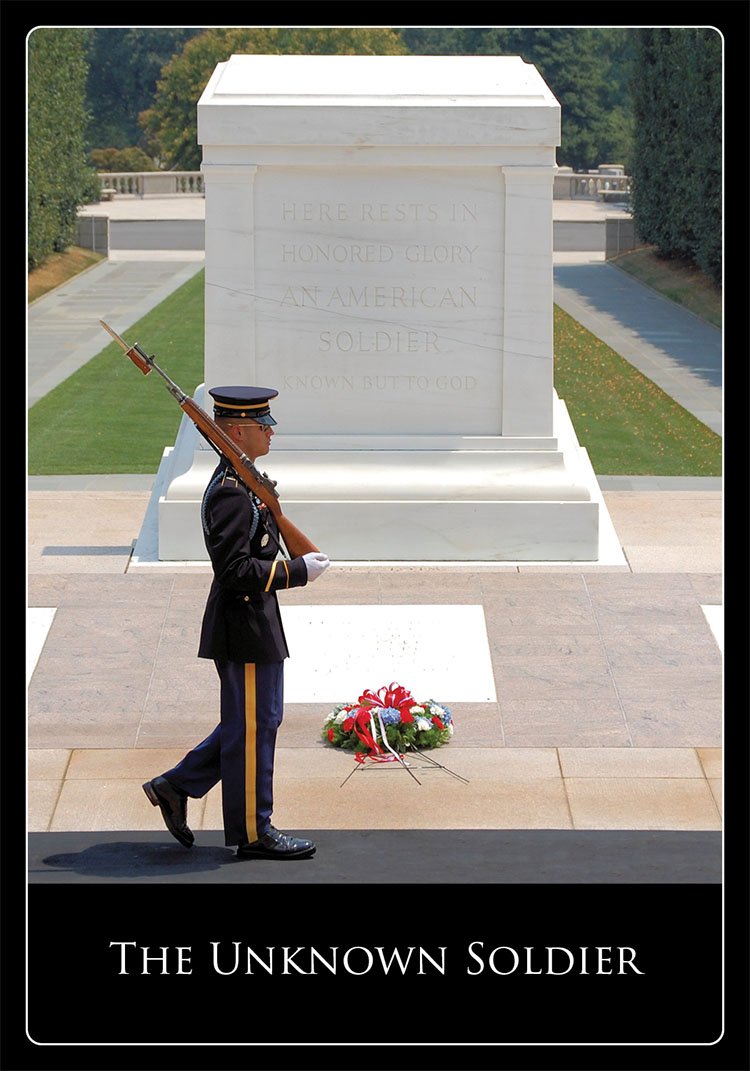Hero Card 1, Card Pack 1
Photo credit: Michael B. Thomas
Three crypts. In front of the Tomb of the Unknown Soldier’s sarcophagus are three crypts—the World War II Unknown, The Korean War Unknown, and the Vietnam War Unknown (now empty). The covering for the empty Vietnam War crypt bears the inscription: “Honoring and Keeping Faith with America’s Missing Servicemen 1958-1975.”
The Unknown Soldier
On November 11, 1921, a horse-drawn caisson carried the remains of an unknown soldier to Arlington National Cemetery. The Tomb of the Unknown Soldier serves as a symbolic grave for all war dead whose remains have not been found or identified. The inscription on the west side of the Tomb sarcophagus reads:
HERE RESTS IN
HONORED GLORY
AN AMERICAN
SOLDIER
KNOWN BUT TO GOD
One of the consequences of warfare has been large numbers of unidentified dead. Sometimes unidentified remains resulted from poor record keeping, the damage that weapons of war inflicted on bodies, or the haste required to bury the dead and mark gravesites. In the United States prior to the Civil War (1861-1865), unidentified remains were often buried in mass graves. At Arlington National Cemetery, these include unknown soldiers and sailors from the War of 1812 who were discovered buried at the Washington Barracks and reburied at Arlington National Cemetery in 1905.
During the Civil War, high casualty rates and lack of personal identification led to large numbers of unknowns originally buried along marching routes or battlefields. While exact numbers are unknown, estimates indicate that nearly half of the Civil War dead were never identified.
In December 1920, New York Congressman and World War I veteran Hamilton Fish Jr. proposed legislation that provided for the interment of one unknown American soldier at a special tomb to be built in Arlington National Cemetery. The purpose of the legislation was “to bring home the body of an unknown American warrior who in himself represents no section, creed, or race in the late war and who typifies, moreover, the soul of America and the supreme sacrifice of her heroic dead.”
Following World War II, some Americans supported the idea of interring and honoring an Unknown from that war. However, the start of the Korean War in 1950 delayed those plans. In August 1956, President Dwight D. Eisenhower approved the selection and interment of Unknowns from both World War II and Korea.
Before the Vietnam War ended, Arlington National Cemetery began making preparations to add a third crypt to the Tomb. However, many people believed that advances in technology would mean that all remains from Vietnam could eventually be identified. On September 17, 1999—National POW/MIA Recognition Day—the third crypt was rededicated to honor all missing U.S. service members from the Vietnam War.
Guarding the Tomb
In March 1926, soldiers from nearby Fort Myer were first assigned to guard the Tomb of the Unknown Soldier. The guards, present only during daylight hours, discouraged visitors from climbing or stepping on the Tomb. In 1937, the guards became a 24/7 presence, standing watch over the Unknown Soldier at all times.
The 3rd U.S. Infantry Regiment, known as “The Old Guard,” was designated as the Army’s official ceremonial unit on April 6, 1948. At that time, The Old Guard began guarding the Tomb of the Unknown Soldier.
Soldiers who volunteer to become Tomb Guards must undergo a strict selection process and intensive training. Each element of the Tomb Guard’s routine has meaning. The Guard marches 21 steps down the black mat behind the Tomb, turns and faces east for 21 seconds, turns and faces north for 21 seconds, and then takes 21 steps down the mat. Next, the Guard executes a sharp “shoulder-arms” movement to place his/her weapon on the shoulder closest to the visitors, signifying that he or she stands between the Tomb and any possible threat. The number 21 symbolizes the highest symbolic military honor that can be bestowed: the 21-gun salute.
Sources
Card Photo: Michael B. Thomas
Arlington National Cemetery: The Tomb of the Unknown Soldier
Arlington National Cemetery Fact Sheet—Tomb of the Unknown Soldier: A Brief History
U.S. Department of Defense: Tomb of the Unknown Soldier Centennial Commemoration





